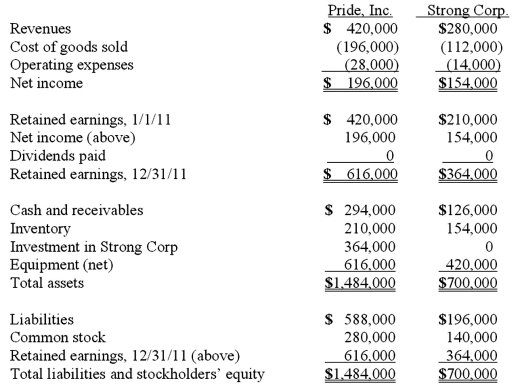On January 1, 2011, Pride, Inc. acquired 80% of the outstanding voting common stock of Strong Corp. for $364,000. There is no active market for Strong's stock. Of this payment, $28,000 was allocated to equipment (with a five-year life) that had been undervalued on Strong's books by $35,000. Any remaining excess was attributable to goodwill which has not been impaired.
As of December 31, 2011, before preparing the consolidated worksheet, the financial statements appeared as follows:
During 2011, Pride bought inventory for $112,000 and sold it to Strong for $140,000. Only half of this purchase had been paid for by Strong by the end of the year. 60% of these goods were still in the company's possession on December 31.
What is the consolidated total for inventory at December 31, 2011?
Definitions:
Offering Size
The total value or amount of securities, such as stocks or bonds, that are made available for sale in a public offering.
Gross Proceeds
The total amount of money received from a transaction before any deductions or expenses are subtracted.
Direct Private Long-term Debt Financing
A method of funding where companies borrow money directly from lenders on a long-term basis without public issuance through financial markets.
Public Issues
Refers to the offering of securities, like stocks or bonds, to the public to raise capital.
Q7: Chapel Hill Company had common stock of
Q22: Watkins, Inc. acquires all of the outstanding
Q30: Which of the following statements is true
Q38: The capital account balances for Donald &
Q45: Coyote Corp. (a U.S. company in Texas)
Q46: Bullen Inc. acquired 100% of the voting
Q57: What is a safe cash payment?
Q60: When a company has preferred stock in
Q74: Withdrawals from the partnership capital accounts are
Q109: Panton, Inc. acquired 18,000 shares of Glotfelty